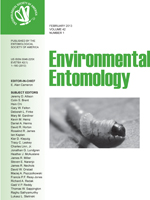For animals that lay eggs, a longstanding question is, why do females choose particular oviposition sites? For insects that lay eggs on plants there are three hypotheses: maximizing suitable habitat for juveniles, maximizing female lifespan, and maximizing egg survival. We investigated the function of the oviposition-site choice behavior of a gall midge, the Hessian fly, Mayetiola destructor (Say). In spite of living less than a day and having hundreds of eggs, the ovipositing female is choosy about the placement of eggs. Choosiness makes sense. The tiny gall-making neonate larva has limited movement and strict requirements for colonization. We examined whether offspring benefit from the Hessian fly female's preference for the plant's youngest leaf. To do this we restricted the female's access to the first, second, or third leaf of a seedling (wheat Triticum aestivum L.) plant. Being placed on older leaves did not impact egg survival or larval survival during migration to attack sites at the base of the plant, but did have negative impacts on egg-to-adult survival (reduced by 48%) and reproductive potential (reduced by 30–45%). These negative impacts appear to come from larvae having to search harder to find the limited number of reactive plant cells that can be reprogrammed to form the gall nutritive tissue. We propose that the ability of larvae to find these reactive cells in spite of being placed on an older leaf is important because it creates leeway for female behavior to evolve in the face of other selection pressures, e.g., attack by egg parasitoids.
How to translate text using browser tools
1 February 2013
Why Oviposit There? Fitness Consequences of a Gall Midge Choosing the Plant's Youngest Leaf
G.A.S.M. Ganehiarachchi,
Kirk M. Anderson,
Jason Harmon,
Marion O. Harris
ACCESS THE FULL ARTICLE
It is not available for individual sale.
This article is only available to subscribers.
It is not available for individual sale.
It is not available for individual sale.

Environmental Entomology
Vol. 42 • No. 1
February 2013
Vol. 42 • No. 1
February 2013
behavior
Cecidomyiidae
insect-plant interactions
performance
preference




